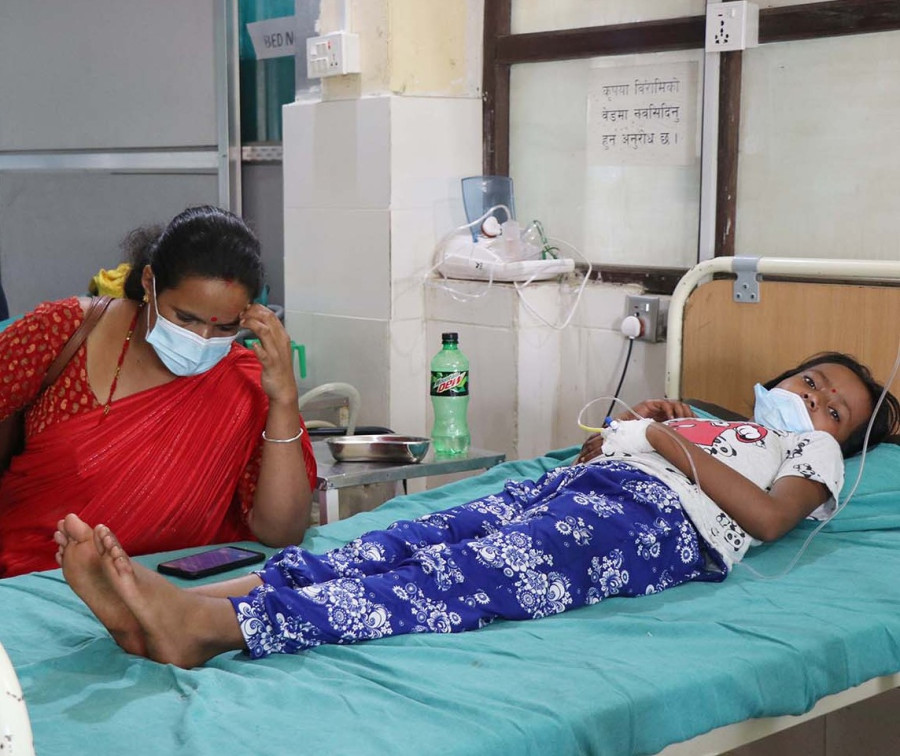Columns
The ignored epidemics
Newer epidemics that didn’t even exist a few years ago ravage places in Nepal now.
Dr Kiran Raj Pandey
Owing to temperate climes, Nepal’s hills and mountains used to be largely spared from the ravages of mosquito-borne diseases, which were a summertime rite of passage for the hot plains down south. However, that is beginning to change.
In the last few decades, mosquito-borne diseases like dengue are sharply increasing in urban habitations along the mid-hills, including the Kathmandu valley. Many have liked to chalk the rise in these diseases to abnormally hot weather patterns caused by climate change. Although the evidence to back this claim is building up, other factors also appear to contribute. Regardless, what is undeniable is that there has been a dramatic uptick in dengue and other mosquito-borne diseases. During this monsoon, while Covid-19 cases were subsiding, Kathmandu’s hospitals were flooded with patients suffering from severe dengue. In September, there were more than 5000 active cases of dengue on any given day in Kathmandu alone. This is unprecedented.
Mosquito-borne diseases such as dengue, chikungunya, zika and Japanese encephalitis are not diseases that Kathmandu, or even Nepal, was used to seeing. Earlier, dengue was thought to be a disease in South East Asia. It wasn’t until 2004 that the first case of dengue was reported in Nepal. In 2006, a limited urban outbreak followed in the districts of the southern plains bordering India. Since then, the dengue virus has constantly encroached the hills up north, first in the lower foothills adjoining the southern plains and now in higher elevations like Kathmandu. With the geographic increase in the spread of the virus, the number of dengue cases has also sharply increased.
In 2010, less than a thousand dengue cases were reported across the country. The previous year, the Sukraraj Infectious Diseases Hospital—one of the city’s major public hospitals—was overflowing with Covid-19 patients from the delta wave of the pandemic. This monsoon, the hospital was similarly overflowing with dengue patients, with many not even getting a place on a hallway gurney. Several thousand more recuperated from dengue infections at their homes, fighting high-grade fever and body aches. Many missed work and their means of livelihood. In September, there were more than 5000 active cases of dengue on any given day in Kathmandu alone.
Although the number of dengue cases is decreasing as the temperature is falling, 57 dengue deaths were verified across Nepal by the first week of November. This is comparable to the 60 or so dengue deaths reported in India this year. This summer, Covid-19 gave way to dengue as the city’s epidemic-in-chief.
In the next few years, mosquito-borne illnesses are expected to rise dramatically. Projections are that by 2070, up to 90 percent of Nepal’s population could live in dengue-endemic areas, compared to 50 percent of the global population. The burden of chikungunya and zika diseases transmitted by the same Aedes variety mosquitoes that transmit dengue could track the trajectory of dengue. Although no official figures have been reported for chikungunya or zika in Nepal, the vector that transmits these diseases is already established in Nepal. Chikungunya was previously documented in Nepal in 2014. During the summers, hospitals in Kathmandu report cases of Japanese encephalitis. Zika is being sporadically reported in India, where the virus could easily be transmitted here. All that is required for an epidemic of these diseases is a sufficiently transmissible variant of these viruses to be introduced in the country.
Rising temperatures and prolonged monsoon rains appear to contribute to this sudden rise in mosquito-borne illnesses. Over the past several decades, temperatures in the central Himalayas and the Himalayan foothills have increased more than in many other places, including the hotter Gangetic plains of South Asia. The Hindukush Himalayan (HKH) region is especially prone to the adverse effects of climate change as temperature changes in this part of the world are set to outpace other areas. We thought of the consequence of the increase in temperatures in terms of the change in weather patterns, unseasonal rains, and melting glaciers. But the more obvious way people may feel the consequence of climate change could be from epidemics that were not present before. Health-related consequences may also be the immediate, more devastating, climate-related burden.
However, rising temperatures aren’t the sole reason mosquito-borne diseases are beginning to ravage urban areas of Nepal. Aedes species mosquitoes that transmit dengue, chikungunya and zika prefer to breed in densely populated places. They prefer the still-water puddles that have become a common sight in our cities due to the encroachment of open areas, natural waterways and drainage systems. Not to mention the heavy traffic that flows from the hotter plains down south into hill cities like Kathmandu. Evidence from Brazil shows that increased vehicular movement from newly constructed transport infrastructure resulted in dengue epidemics.
This doesn’t bode well. Already this summer, our health-care systems struggled to manage the burden of dengue illness. Not only were there more patients than our health-care system could comfortably handle, the variety of complications people experienced was unanticipated. Hospitals across the country had to deal with many patients who suffered from organ failures—liver, heart, and even brain—resulting from severe dengue illness. Several dozen succumbed to their illnesses.
Zika, chikungunya and Japanese encephalitis could wreck similar devastating public health tolls. The zika outbreaks of the last decade in Brazil left hundreds of thousands of kids being born with small heads and mental deficits, the consequences of which Brazil will have to deal with for an entire generation. The Japanese encephalitis burden causes significant mortality in parts of South-East Asia and is now causing significant public health and economic harm in India and Bangladesh. This could be our reality too.
Fortunately, there is a way to deal with it. Over the past decade or so, cities like New Delhi have done a commendable job in controlling the burden of dengue and related illnesses. This summer, while dengue broke out in Delhi, it recorded fewer cases than in Kathmandu, with no deaths. We could do that in our cities too. Public health measures to control the disease are imminently executable. Environmental modification efforts like breeding ground removal, hotspot chemical fogging and improving public sanitation are highly effective interventions in controlling mosquito-borne diseases. Without concerted control efforts, these newer epidemics will only worsen in the years ahead. We ignore them at our own peril.




 5.44°C Kathmandu
5.44°C Kathmandu















